Saturday, February 19, 2005
Billon antoninianus, Gallienus, Rome, Göbl 98q
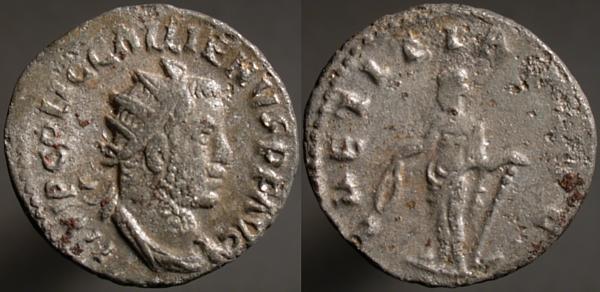
IMP C P LIC GALLIENVS P F AVG, Radiate cuirassed bust right | LAETITIA AVGG, Laetitia standing facing, head left, holding wreath left, leaning on anchor right.
Long obverse legends are characteristic of the period of the joint reign of Gallienus and Valerian, his father, who came to a bad end.
Friday, February 18, 2005
Æ21, Alexandria Troas, Valerian, SNG Copenhagen 195
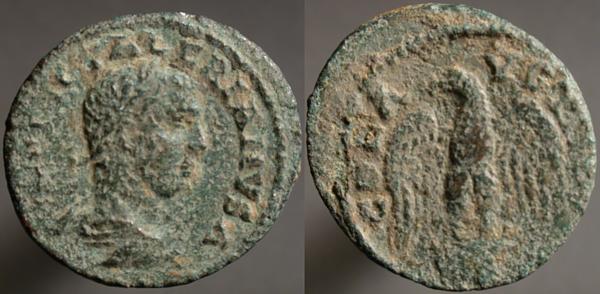
[IMP] LIC VALERIANVS A, Laureate draped bust right | COL A_VG T[RO], Eagle standing facing on bucranium, head left, wings spread.
Four months ago I posted a nicer-looking Gallienus coin with this reverse.
The legend breaks on the coins of this city seem to differ from die to die, as though fitting the legend in was what was important.
Thursday, February 17, 2005
Billon antoninianus, Gallienus, Mediolanum, Göbl 1220c
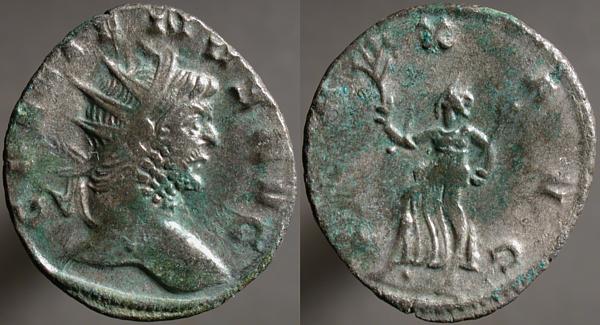
GALLIENVS AVG, Radiate head right | PAX AVG, Pax advancing left, holding branch left and long scepter right.
This odd-looking bust (we're supposed to be looking over his shoulder, from behind his back, I think) was used with a number of reverses at Mediolanum (today Milan) at the time. Judging by his expression, Gallienus wasn't thrilled with it either.
Wednesday, February 16, 2005
AR antoninianus, Elagabalus, Rome, RIC 138
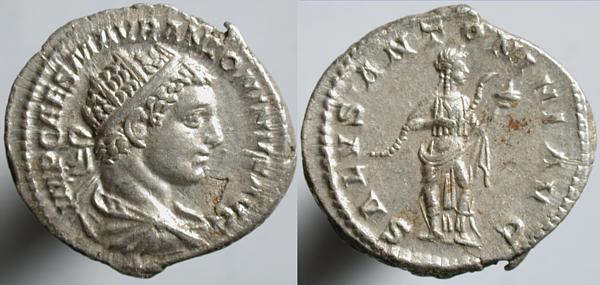
IMP CAES M AVR ANTONINVS AVG, Radiate draped bust right | SALVS ANTONINI AVG, Salus standing facing, head right, feeding snake from patera, right.
Marcus Aurelius Antoninus, born Varius Avitus Bassianus, was either more twisted than Caligula and Nero together, or the victim of the most persistent and successful whispering campaign ever.
Gibbon was unkind. I'll choose to believe him, for the most part.
The army proclaimed Elagabalus emperor in 218 and he quickly set about disillusioning just about everyone. He married and soon divorced Cornelia Paula, a friend of his Mother's, then married Aquilia Severa, a Vestal virgin. That marriage also ended in divorce, and was followed by marriage to Annia Faustina, whom he soon divorced to return to the Vestal. None of these marriages produced offspring.
He is widely rumored to have been engaged in thoroughly unRoman diversions, which I hesitate to specify for fear of unwanted Googling. Read the links above.
By 221 his family was growing concerned for the future, and forced him to adopt his cousin Severus Alexander and install him as heir. An attempt by Elagabalus to have Alexander assassinated the next year failed and led to his own assassination.
Tuesday, February 15, 2005
Æ21, Philippi in Macedonia, Gallienus, Varbanov 3242
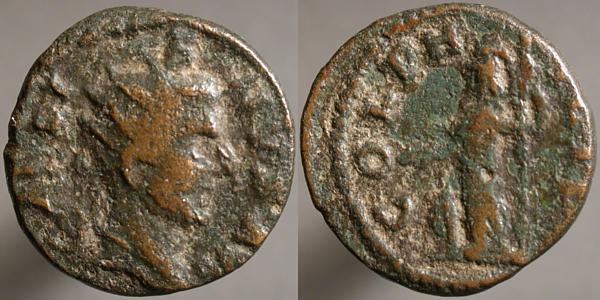
GALLI_E_NVS AVG, Radiate head right | COL PH[ILIP], Minerva standing left, holding spear right, sacrificing from patera left.
The seller didn't attribute this beyond the emperor, and it took me a few hours. The portrait and overall appearance looked to me like something from Thrace, and I wasn't far wrong, Macedonia's close by, but first I had to run through the colony cities in Thrace. After then looking though a list of cities on Wildwinds, a wonderful site for research, looking for colonies with names starting with 'PH'. After a few false starts, I settled in on Philippi, site of the battle in which the forces of Antony and Octavian defeated the assassins of Caesar. This event is remembered on this small bronze coin, common and easy to find, but issued by an uncertain Julio-Claudian emperor.
Tracking the coin down further required the use of the Varbanov books, which are in Bulgarian, which I neither read nor speak. It was a challenge, but after am making an approximate transliteration with this page, I found what I wanted. I look forward to the day these volumes are published in English.
Monday, February 14, 2005
Billon antoninianus, Gallienus, Rome, Göbl 547h
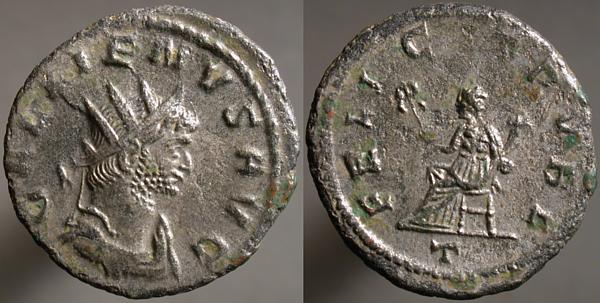
GALLIENVS AVG, Radiate draped cuirassed bust right | FELICIT PVBL, Felicitas seated left, holding overflowing cornucopia right and caduceus left. T in exergue.
The seller's photograph and my own expectations had me thinking this was a variant of this, with a cuirassed bust, but with one ribbon forward across the emperor's shoulder, a bust which Göbl doesn't attest for this reverse. Instead it's a draped and cuirassed bust, not often seen at the mint of Rome at this time. Göbl does attest two examples of that bust with this reverse, so it's not a new discovery, but it's still quite desirable (well, as these ugly little coins go) and not anything I already had.
Sunday, February 13, 2005
Æ31, Tarsus in Cilicia, Gallienus, SNG Copenhagen 409
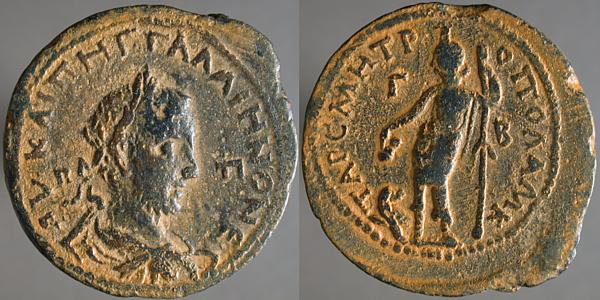
AV KAI Π HΓ ΓAΛΛIHNON E C, Laureate draped bust right. Π before and behind | TAPC MHTP_OΠOΛ A M K, Dionysus standing left, holding thyrsus right, pouring from kantharos left. Panther at feet left. Γ in left field, B in right.
ΣΙΔΗ, ancient Greek for pomegranate, was a homonym for the name of the city, and the pomegranate became a punning shorthand badge.
This has seen some wear, and some deterioration since, but it's in quite satisfactory state.
Dionysus was a bit enimgmatic, a friend to man but the object of wild ecstatic worship that could get a bit rough. The thyrsus he carries is thought by some to be related to the brooms witches were said to ride.

